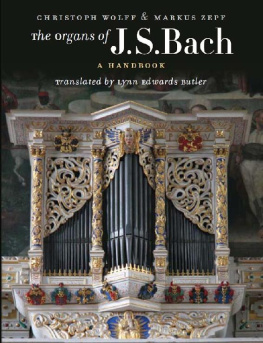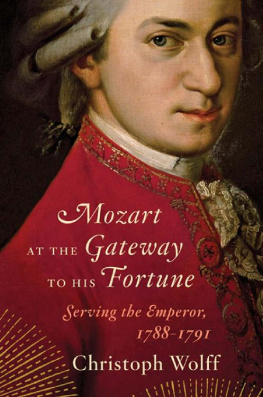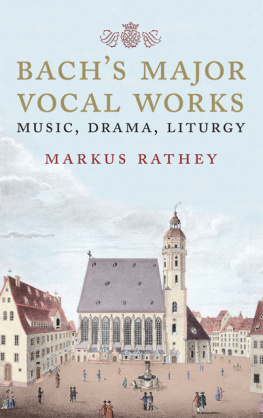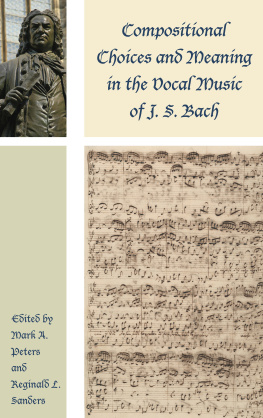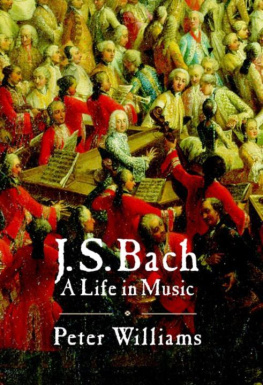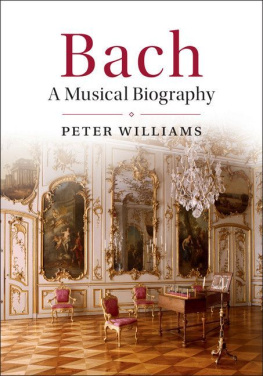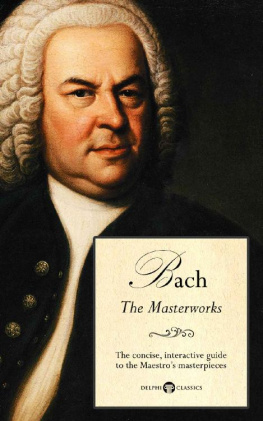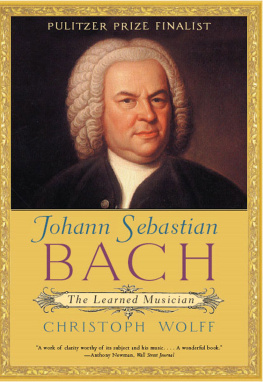Contents
Guide

ALSO BY CHRISTOPH WOLFF

BACH:
Eine Lebensgeschichte in Bildern A Life in Pictures
(bilingual edition)
Mozart at the Gateway to His Fortune:
Serving the Emperor, 17881791
Johann Sebastian Bach:
The Learned Musician
Mozarts Requiem:
Historical and Analytical Studies, Documents, Score
Bach:
Essays on His Life and Music

Johann Sebastian Bach, oil portrait by E. G. Haumann (1748). Bach-Museum, Leipzig.
BACHS
MUSICAL
UNIVERSE
The Composer and His Work

CHRISTOPH
WOLFF

Copyright 2020 by Christoph Wolff
All rights reserved
First Edition
For information about permission to reproduce selections from this book, write to Permissions, W. W. Norton & Company, Inc., 500 Fifth Avenue, New York, NY 10110.
For information about special discounts for bulk purchases, please contact W. W. Norton Special Sales at specialsales@wwnorton.com or 800-233-4830
Jacket design: Yang Kim
Jacket art: Johann Sebastian Bach (oil on canvas), by E. G. Haumann / Bach-Archiv Leipzig, Germany
Book design by JAM Design
Production manager: Anna Oler
The Library of Congress has cataloged the printed edition as follows:
Names: Wolff, Christoph, author.
Title: Bachs Musical Universe : the composer and his work / Christoph Wolff. | Includes bibliographical references and index.
Identifiers: LCCN 2019045952 | ISBN 9780393050714 (hardcover) |
ISBN 9780393651799 (epub)
Subjects: LCSH: Bach, Johann Sebastian, 16851750Criticism and interpretation.
Classification: LCC ML410.B13 W63 2020 | DDC 780.92dc23
LC record available at https://lccn.loc.gov/2019045952
W. W. Norton & Company, Inc., 500 Fifth Avenue, New York, N.Y. 10110
www.wwnorton.com
W. W. Norton & Company Ltd., 15 Carlisle Street, London W1D 3BS
CONTENTS


- BWV = Bach-Werke-Verzeichnis (see Bibliography).
- BWV 00/0 = BWV 00, movement 0 (e.g., BWV 38/6 = BWV 38, movement 6).
- BWV 00.0 = BWV 00, version 1, 2, etc. (e.g., BWV 782.2 = BWV 782, second version).
- Major keys are at times notated as capital letters, minor keys as lowercase (A = A major, b = B minor).


T he title Bachs Musical Universe is intended to signal that this book will pursue a path quite distinct from the conventional composer and his work approach. A critical examination of the entirety of Johann Sebastian Bachs musical output would only be a frustrating exercise in futility. The composer left such an astonishingly rich legacy of music that no single study could adequately address and cope with all of his works. Out of sheer necessity, then, I have decided to focus on a limited but highly significant array of works, a selection unlike any other made before. Studies of Bachs music are customarily organized around compositions of similar kinds, in the same or related genres, or from within the same time period. The selection made for this book, however, cuts across the conventional boundaries, and has in a sense been determined by the composer himself. Throughout his creative life, Bach methodically organized certain works of exemplary status, unique features, and innovative character in carefully designed collections, manuscript fair copies, and publications. These benchmark works, all of them without parallel or equivalent, introduced an extraordinary succession of highly original creations that were clearly meant to stand as paradigms of his musical art. They reveal an inquisitive and constantly searching musical mind that never lost the sense of discovery, and as such they present perhaps the most powerful and authentic musical autobiography imaginable.
Emerging from an extensive and highly complex oeuvre, a remarkable array of compositionsfrom the early set of six keyboard toccatas through the late Art of Fugue and B-minor Mass metaphorically offer a vision of discernible planets within the greater firmament of Bachs music, distinctly organized units that illustrate the composers sense of variety and the grasp for breadth and depth as his musical universe steadily unfolded. Largely independent of the external course of his life, Bachs universe resembles a grand cosmos wherein his boundless musical ideas all find their places. I will leave it at that and not push the metaphor any further into asteroids, black holes, and other regions of astronomy.
Another aspect of this book concerns its relationship to the long and abundant heritage of Bach studies. For all of the works and collections considered here, there are multiple dedicated monographs, book chapters, scholarly articles, and concise introductions available. Many of these have guided generations of Bach researchers and enthusiasts, with more recent publications continuing to inform and inspire up to the present moment. Yet all these various publications could not be listed in the bibliography at the end of this book, except for a few that specifically required mention. I am pursuing, in effect, an independent meta-study, whose primary intent is to focus on distinct overarching designs that are discernible within Bachs superabundant musical output. Such an essentially synoptic approach to Bachs oeuvre puts into sharper view the composers inquisitive musical mind, which produced such a remarkably steady stream of transformational works.
For all the compositions under consideration, this volume considers aspects of genesis (with an emphasis on primary sources), salient musical features, and other essential facets of historical import and general consequence. I have also included concise illustrative tables for collections and individual pieces, designed for convenient reference and informative overview. Yet the chapters and sections of this book cannot fully live up to the music itself: they do not aspire to present detailed analyses, nor are they meant to supplant existing critical introductions to the works under consideration. Instead, they complement what is available in existing literature. In this book, I have drawn freely on my earlier writings, teachings, and research, but in conceiving its focus and thrust I primarily intended that it supplement and complete the picture offered in my biographical study, Johann Sebastian Bach: The Learned Musician (Norton, 2000).
Although the present study relates closely to the earlier book, my Bach biography is referenced only occasionally, vis--vis specific biographical information and other essentials. In general, any Bach biography can provide sufficient background. Important dates are presented in a brief synopsis at the end of this volume. Since Bach scores are readily available, musical examples have been kept to a minimum. Facsimiles of original sources provide much supplemental information regarding the chosen works, and draw the reader closer into their historical context. The facsimile pages reproduced in this book are extensively complemented by Bach digital , the comprehensive digital library of Bach manuscripts made available by the Leipzig Bach Archive, which provides navigation instructions in English (www.bach-digital.de). For searching secondary literature, readers might find useful the Bach Bibliography Online (www.bach-bibliographie.de), maintained by the Leipzig Bach Archive as well.


